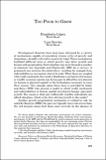Artículo
Too poor to grow
Date
2015Abstract
Development theorists have long been intrigued by a variety of mechanisms capable of generating vicious cycles of poverty and stagnation—broadly referred to as poverty traps. These mechanisms highlight different ways in which poverty may deter growth and become self-perpetuating. Such situation may arise through a number of channels (see Azariadis and Stachurski 2005 for a survey). A prominent one involves threshold effects resulting for example from indivisibilities or increasing returns to scale. When these are coupled with credit constraints the result is that below a certain level of income or wealth economic agents may be too poor to afford the investments (in human or physical capital) or the technologies necessary to raise their income. One example along these lines is provided by Galor and Zeira (1993) who present a model in which credit constraints and indivisibilities in human capital investment hamper aggregate growth. The reason is that only sufficiently wealthy individuals can afford education which is the force driving growth in the model.
Collections
View/


